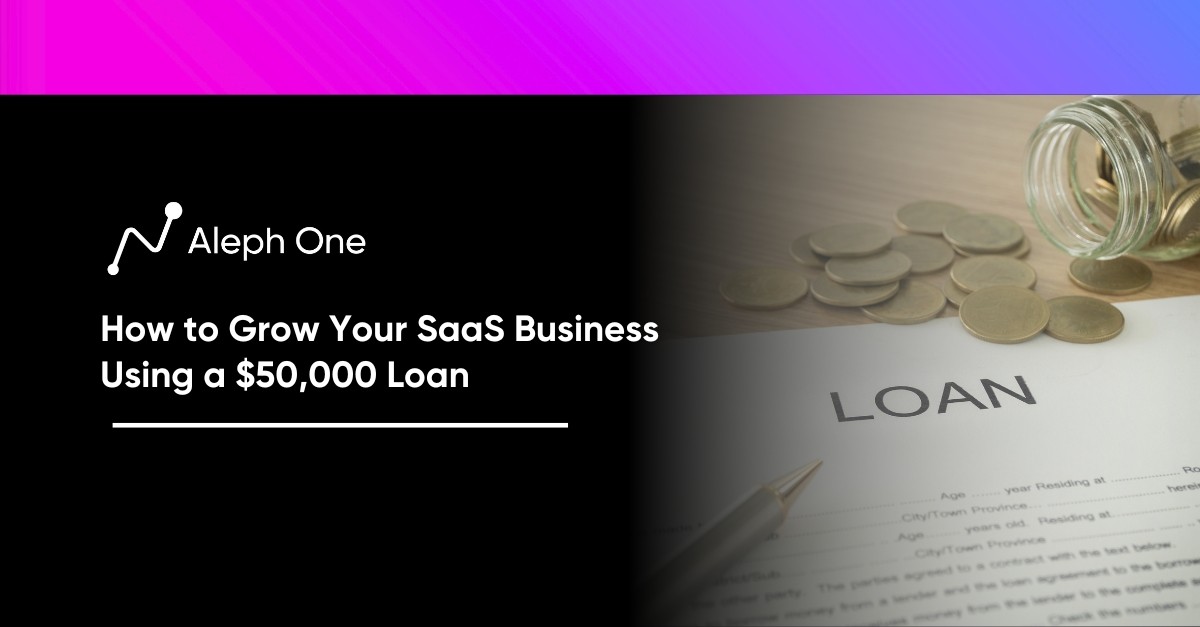Let’s work together to build something amazing. Share your project details and our team will reply to figure out the next steps to your success.

Are you a SaaS entrepreneur dreaming of taking your business to new heights but lacking the necessary funds? Imagine the possibilities if you had a $50,000 loan at your disposal. This article unveils the secrets to growing your SaaS business using that loan. From optimizing your key metrics to qualify for funding, leveraging recurring revenue as collateral, and exploring the benefits of debt funding versus equity, we’ll guide you through securing the capital you need. Get ready to discover how to strategically allocate your $50,000 to propel your SaaS business toward unparalleled success and unlock its full potential in the competitive market.

Optimize Your SaaS Metrics to Qualify for Funding
To qualify for funding, SaaS companies must demonstrate critical metrics that prove their business model and potential for growth. Metrics like monthly recurring revenue (MRR), churn rate, customer lifetime value (LTV), customer acquisition cost (CAC), and payback period are critical for attracting both debt and equity investors.
Steady MRR Growth
SaaS companies should aim for steady MRR growth, indicating strong and consistent demand for their product. A low churn rate, ideally under 5% per month, shows customers see the lasting value and stay with the service. A high LTV to CAC ratio of 3 to 1 proves that the revenue exceeds the acquisition cost. A short payback period, under 12 months, means the company can recoup CAC costs, an appealing quality.
Drive Retention
Optimizing these metrics may require changes like improving product features to drive retention, developing educational content to lengthen customer lifespans, streamlining the sales process to reduce CAC, or tightening payment terms to decrease payback periods. While adjustments may take time, consistent progress will make the business attractive to funders.
Asana – Product Experience and Support
For example, the project management tool Asana focused on these metrics early on. By improving product experience and support, Asana extended its average customer lifetime to over eight years and lowered churn by under 5% per year. With MRR growth of over 50% annually and LTV to CAC over 10 to 1, Asana raised $50 million in Series C funding in 2017.
Drip – Optimization
Similarly, Drip’s email marketing platform improved its trial conversion rates, onboarding, and customer education. They increased MRR by over 25% per year, lowered churn by under 3% per month, and hit a 6 to 1 LTV to CAC ratio. Drip raised $27 million in Series A funding based on these metrics’ strength in 2018.
Optimizing key SaaS metrics like MRR growth, low churn, and a high LTV to CAC ratio demonstrates the viability and potential of a SaaS business model. Vital metrics make a company an attractive candidate for substantial funding from investors and lenders eager to back high-growth technology companies.
Recurring Revenue is Your Friend: Use it as Collateral
For SaaS businesses, recurring revenue is the gift that keeps on giving. Your subscribers pay you month after month, providing predictable income you can count on. This reliable revenue stream also attracts lenders, who see it as collateral against their loans. Some specialized lenders offer “revenue-based financing” that lets you borrow money against your future recurring revenue.
How to Qualify for Revenue-based Financing
To qualify for revenue-based financing, you must demonstrate substantial growth in recurring revenue, typically called Monthly Recurring Revenue or MRR. Many lenders want to see at least 10-30% MRR growth over the past 6-12 months. They will evaluate critical metrics like your customer churn rate, customer lifetime value (LTV), and payback period. The lower your churn and the higher your LTV and payback period, the more funding you can raise.
SaaS Recurring Revenue Example
For example, if your SaaS business has $50,000 in MRR and a 5% monthly churn rate, your annual recurring revenue would be $600,000. A lender may provide a loan of $200,000-$500,000 as they expect much of that revenue to recur over the next few years. The exact amount will depend on your growth rate and other metrics. The loan is repaid with a percentage of your future MRR, often 5-10%, until the principal is repaid.
Downsides of Revenue-based Financing
This type of financing is ideal for fast-growing SaaS companies as payments scale up with your revenue growth. The downside is that lenders charge higher interest rates than traditional bank loans to account for the risk. It also means giving up a percentage of your future revenue. However, for many SaaS founders, the opportunity to access growth capital without diluting equity outweighs these potential downsides.
Recurring SaaS revenue can be leveraged to secure financing that fuels your growth. By optimizing key metrics around churn, LTV, and payback period, you can raise more money from revenue-based lenders to invest in sales, marketing, and product development.
Debt Funding: Cheaper Than Equity But More Strings Attached
While equity funding from investors is ideal for many fast-growing SaaS companies, debt funding through loans and lines of credit can be a cheaper alternative. With debt, you avoid giving up ownership of your company. However, debt also comes with obligations to make fixed payments and meet certain financial covenants.
Loans and Lines of Credit
Loans and lines of credit typically charge lower interest rates than equity investments. The interest is also tax deductible, reducing your costs. However, your company needs to work on making payments or meet revenue and profit milestones tied to the debt. In that case, lenders can demand repayment and even force the company into bankruptcy as a last resort.
Risk of Defaulting Debt
The debt default risk is lower for SaaS businesses with predictable recurring revenue. But there is still a chance of missing financial targets if growth slows or churn increases. When taking on debt, consider how much your business can afford to pay back even during tough times. It is best to be conservative with estimates to avoid overextending yourself.
Case Study – HubSpot
Some SaaS companies have successfully used debt funding to fuel growth without losing ownership control. For example, HubSpot took out a $35 million line of credit in 2016 to fund expansion into new markets. The company was able to pay back the debt within two years due to strong revenue growth. However, other SaaS businesses like Wagepoint had to restructure their debt payments after missing financial covenants, diluting ownership.
Lenders and Products Tailored for Recurring Revenue Companies
If considering debt funding for your SaaS business, look for lenders and products tailored to recurring revenue companies. Revenue-based lenders like Lighter Capital and Clearbanc offer “royalty financing” and flexible lines of credit that scale payments with your growth. Convertible notes are also popular, allowing lenders to convert debt to equity under certain conditions.
For SaaS businesses, debt funding can be a double-edged sword. While cheaper and less dilutive than equity, debt also introduces more risk and obligations that could hurt your company if not managed properly. However, with financial discipline and conservative planning, debt can successfully fuel growth without losing control.
Pitching SaaS Investors: What You Must Know
To raise funding from investors, you must pitch your SaaS business compellingly. SaaS investors want to see a significant market opportunity, a competitive advantage, and the potential for high growth. Focus your pitch on the key things that will get investors excited.
Start with the problem your product solves. Explain the pain points you are addressing and quantify the potential market size.
Highlight Your Competitive Advantage
Next, highlight your competitive advantage. What makes your product unique? Why will customers choose you over alternatives? Your intellectual property, data assets, or innovative technology can provide a competitive edge.
Share Your Business Model
Then, share your business model and how you will scale. Discuss your pricing, customer acquisition, and unit economics. Explain how you will ramp up marketing and sales to drive rapid growth.
Startup Team
Your team is critical. Highlight the key members of your team and their experience building and scaling successful SaaS businesses. Discuss any key hires you need to execute your growth plan.
Financial Projections
Provide financial projections demonstrating the potential for high growth and strong margins over the next 3-5 years. Share key metrics around revenue, customers, churn, lifetime value, and payback period. Explain any key milestones or inflection points in your projections. Investors want to see that you have a realistic plan to scale the business.
Examples of successful SaaS pitches include Drift, Intercom, and HubSpot—study pitches from fast-growing SaaS companies to learn what resonates with investors. With a compelling pitch that checks all the boxes, you will be on your way to raising the funding you need to grow your SaaS business.
Consider A Revenue-Based Loan: Payments Scale With Your Growth
A revenue-based loan is a type of financing where the amount you repay scales with your revenue growth. This model suits fast-growing SaaS companies because payments align with your ability to pay. If revenue slows, your costs decrease.
For example, a lender may provide you with a $50,000 loan and, in exchange, take 5% of your monthly revenue until the loan is repaid. If your revenue is $100,000 per month, the payment would be $5,000. But if revenue grows to $200,000 the next month, the payment increases to $10,000. The loan is repaid once total payments reach $50,000.
The revenue-based lending market has grown quickly, increasing by over 34% in 2018, according to a report by the Revenue-Based Finance Coalition. Lenders like Lighter Capital, Fleximize, and Capchase offer revenue-based loans and lines of credit from $10,000 to $10 million to B2B SaaS companies. They analyze your revenue metrics, growth, and default risk to determine an offer.
Benefits of Revenue-based Financing
The main benefits of revenue-based financing are that payments scale with growth, are non-dilutive, and the application process is often faster than bank loans. However, the interest rates are often higher, payments fluctuate, and lenders may take an equity stake. It also only works for companies with recurring revenue.
SaaS companies like Wistia, Dozuki, and Webflow have used revenue-based loans to invest in product development, marketing, and hiring without giving up equity. The loans gave them flexibility and allowed them to scale payments with their rapid growth. For fast-growing SaaS companies, revenue-based financing can be an attractive option to fund development and maintain control of your business.
How to Allocate $50K: Spend Money to Make Money
With $50,000 in funding, you can make critical investments that can fuel the growth of your SaaS business. Focus the spending on areas that will directly drive higher revenue and lower churn.
Bringing in New Talent
One of the best investments is hiring talent, especially in product, marketing, and customer success roles. Bringing on a product manager or designer can help you improve your software and release new features that attract more customers. A marketing manager can scale your customer acquisition efforts through strategies like content creation, search engine optimization, and targeted ad campaigns. A customer success representative can boost retention and upsells by providing high-touch support and advocacy for your customers. While $ 50K will only pay for some of these roles full-time, you can hire contract or part-time help to start.
Marketing and Sales
You should also allocate a budget to scale your startup marketing and sales activities. For example, you can spend $10-15K on content creation, guest blogging, and influencer marketing to increase traffic and leads. You can also boost your advertising spend on channels like LinkedIn, Facebook, and Google Ads to improve lead generation. If your sales process includes demos or trials, invest in tools to make signing up and onboarding customers as seamless as possible. These efforts can significantly impact your customer acquisition numbers.
Customer Experience
Reducing churn is critical to sustainable SaaS growth, so spend money on improving your customer experience. You may invest $5-10K in customer education, onboarding tools, in-app messaging, and feedback surveys. You should also consider offering your customers educational resources and ongoing training/support. Holding local meetups or online events are other valuable ways to engage your customers and promote retention.
Succeed on a Learn Budget Startup Growth
While $50K is a relatively small, targeted spending in talent, marketing, sales, and customer success can outsize your key SaaS metrics. By focusing on revenue growth and churn reduction, you’ll be in a solid position to qualify for additional funding to accelerate your development. With a data-driven approach, $50K can go a long way toward building a successful SaaS business.
Get the latest news and updates from Aleph One in your inbox.



